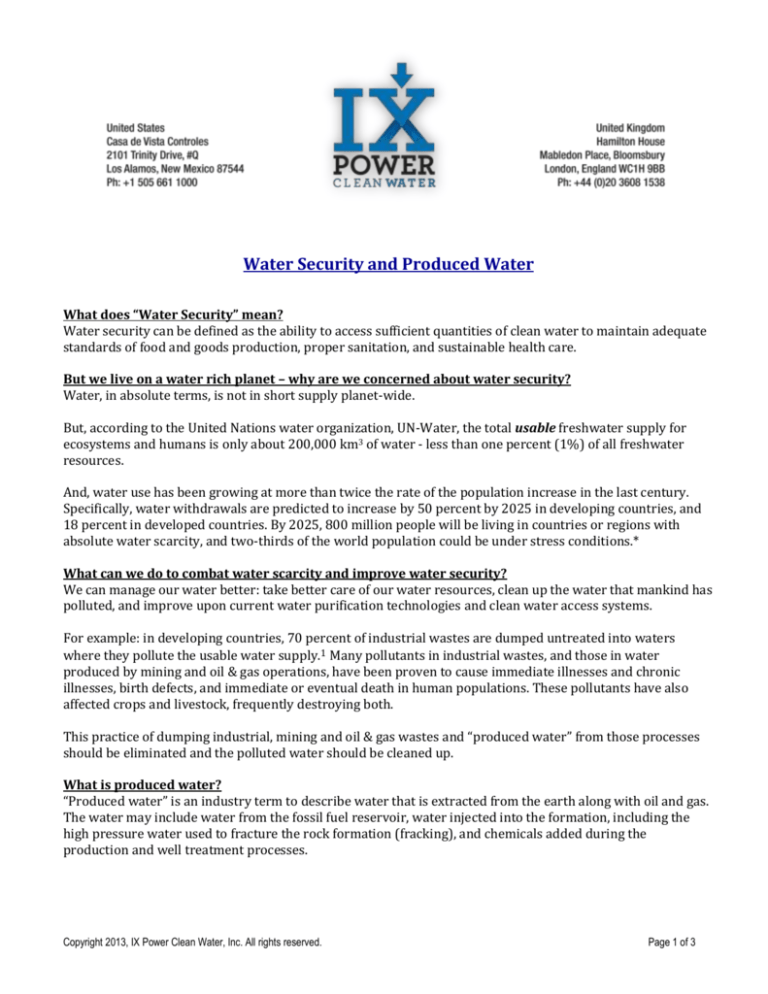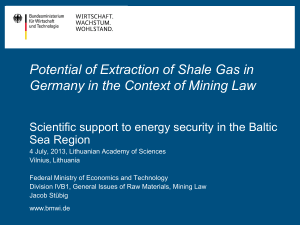
Water Security and Produced Water
What does “Water Security” mean?
Water security can be defined as the ability to access sufficient quantities of clean water to maintain adequate
standards of food and goods production, proper sanitation, and sustainable health care.
But we live on a water rich planet – why are we concerned about water security?
Water, in absolute terms, is not in short supply planet-wide.
But, according to the United Nations water organization, UN-Water, the total usable freshwater supply for
ecosystems and humans is only about 200,000 km3 of water - less than one percent (1%) of all freshwater
resources.
And, water use has been growing at more than twice the rate of the population increase in the last century.
Specifically, water withdrawals are predicted to increase by 50 percent by 2025 in developing countries, and
18 percent in developed countries. By 2025, 800 million people will be living in countries or regions with
absolute water scarcity, and two-thirds of the world population could be under stress conditions.*
What can we do to combat water scarcity and improve water security?
We can manage our water better: take better care of our water resources, clean up the water that mankind has
polluted, and improve upon current water purification technologies and clean water access systems.
For example: in developing countries, 70 percent of industrial wastes are dumped untreated into waters
where they pollute the usable water supply.1 Many pollutants in industrial wastes, and those in water
produced by mining and oil & gas operations, have been proven to cause immediate illnesses and chronic
illnesses, birth defects, and immediate or eventual death in human populations. These pollutants have also
affected crops and livestock, frequently destroying both.
This practice of dumping industrial, mining and oil & gas wastes and “produced water” from those processes
should be eliminated and the polluted water should be cleaned up.
What is produced water?
“Produced water” is an industry term to describe water that is extracted from the earth along with oil and gas.
The water may include water from the fossil fuel reservoir, water injected into the formation, including the
high pressure water used to fracture the rock formation (fracking), and chemicals added during the
production and well treatment processes.
Copyright 2013, IX Power Clean Water, Inc. All rights reserved.
Page 1 of 3
What is in “produced” water?
Major constituents of produced water are salt, oil and grease, various other natural inorganic and organic
compounds, chemical additives used in drilling and fracking, and naturally occurring radioactive material
(NORM).
For example, according to a U.S. Geological Survey report wastewater from Marcellus Shale natural gas wells
that have been hydraulically fractured is 300 times higher in radiation than the Nuclear Regulatory
Commission's limits for industrial discharges. The Marcellus Shale formation contains significant quantities of
uranium and its daughters: radium, etc. (Interestingly, nuclear power plants in the U.S. are much more highly
regulated than fracking processes; hardly any radiation emission is tolerated at nuclear utilities.)
How much produced water is produced annually?
Worldwide, the volume of produced water generated each year exceeds 70 billion barrels (1 bbl = 42 U.S.
gallons), 20 billion in the U.S. alone. Worldwide, that equates to nearly 200 million barrels of produced water
each and every day – enough water to flow over Niagara Falls for 3 months. It is by far the largest volume, at
98%, of the entire waste stream generated by the oil and gas industry.
Specifically, what can be found in “produced” water that may be toxic?
BTEX is one set of compounds that is of major concern. BTEX is an acronym that stands for Benzene, Toluene,
Ethylbenzene, and Xylenes, which are closely related. These compounds are soluble in water so produced
water from the extraction of crude oil is contaminated always with these compounds.
What health impacts has BTEX been known to have on humans?
Benzene is carcinogenic while Toluene, Ethylbenzene, and Xylenes have harmful effects on the central nervous
system. Frequently found together, the BTEX compounds can cause illness, birth defects, eventual death and
even immediate death if highly concentrated. (A separate paper is available on this site about BTEX.)
What have been the options for dealing with produced water thus far?
To summarize, solutions to the produced water problem can be broadly divided into four areas: subsurface
disposal, surface disposal, clean for re-use in extraction, and clean for beneficial use.
What is the ratio between oil and produced water from a typical Oil and Gas well?
For each barrel of oil recovered, 5 to 40 times as much water is produced, creating the adage that “oil recovery
is really water recovery with a bit of oil thrown in.” In fact, produced water accounts for 98% of the waste
products in the oil & gas industry, and costs industry nearly $40 billion each year.
How much money do Oil and Gas Companies spend on produced water management?
Each year, in order to comply with local, state, provincial, and federal environmental laws, oil and gas
companies spend an estimated $40 billion cleaning and/or disposing of produced water. Costs include
transportation, pre-treatment, re-injection, and desalination, and vary widely depending upon the water’s
properties, volume, and geographic location. Typical handling costs range from $2 to $10 per barrel of water,
and can run as high as $15 per barrel.
Copyright 2013, IX Power Clean Water, Inc. All rights reserved.
Page 2 of 3
What regions would benefit most from having their produced water cleaned?
Regions where water scarcity and oil & gas production intersect e.g. Southwest United States, the Middle East,
and parts of Africa.
What is “Found” Water and what can be done with produced water that has been cleaned?
“Found” water is usable water that is created, or found, by cleaning “produced” water from oil and gas
production that would have normally been discarded as wastewater. Found water is a new water resource
that can be used for agriculture, livestock and community water systems. Crop/food production in arid
regions could be increased substantially by using found water created by cleaning produced water from local
oil & gas operations, mining or other industry. In short, found water from produced water could help the
global “water security” problem which in turn would help the global “food security” problem. (See additional
FAQ entries on Food Security.)
What is IX Power Clean Water developing to create clean found water from produced water?
IX Power Clean Water (IX PCW) is currently refining and commercializing proven technology created by
scientists at Los Alamos National Laboratory (LANL) that will change how the world manages produced water
from the oil & gas industry, mining industry, and manufacturing. As part of a water treatment train, this new
technology eliminates the organic hydrocarbons (BTEX) in produced water, enabling the water to be cleaned
to the point that it can be safely used for agriculture, livestock, and community water systems.
— IX —
1
. http://www.unwater.org/statistics_pollu.html
Copyright 2013, IX Power Clean Water, Inc. All rights reserved.
Page 3 of 3












